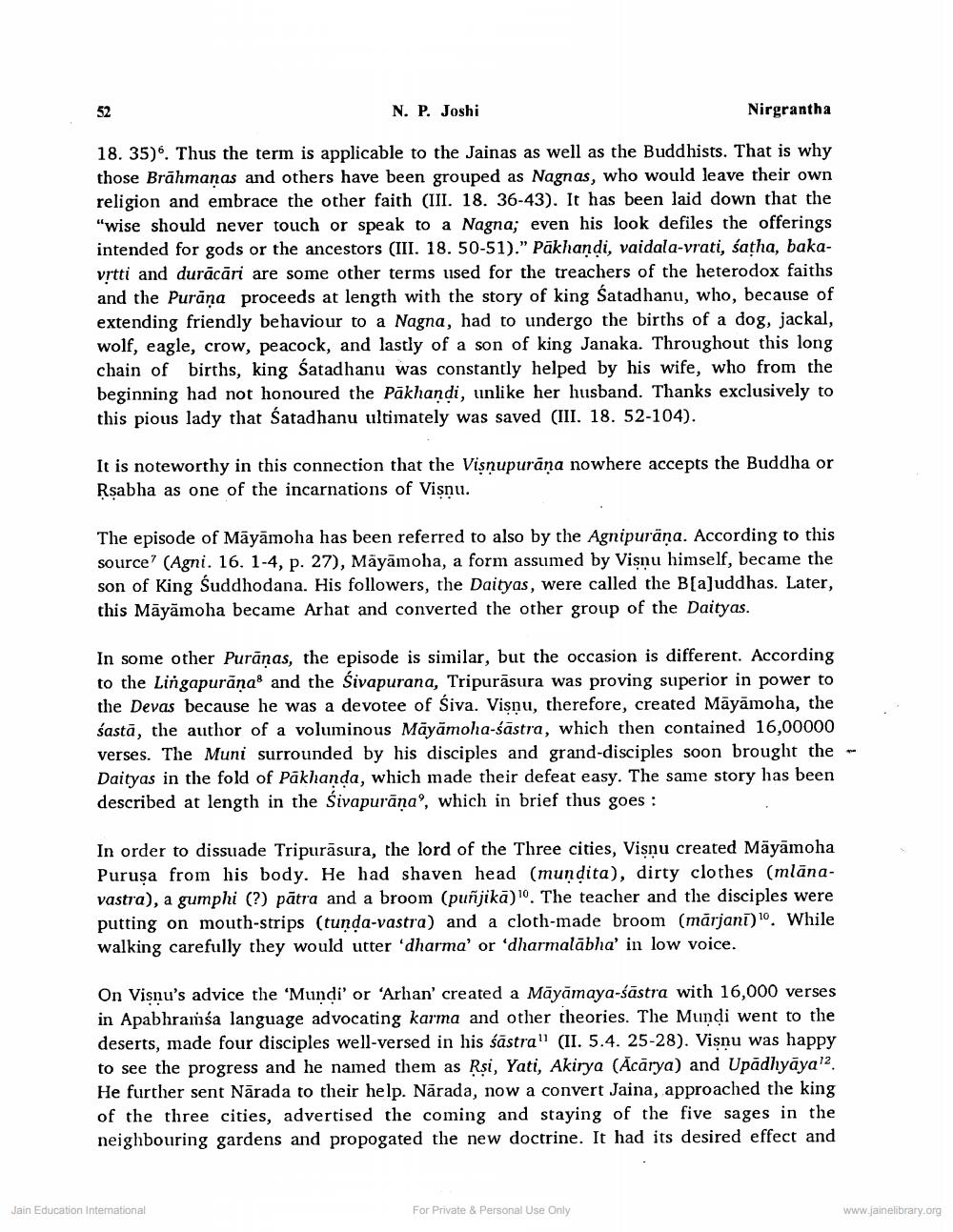________________
52
Nirgrantha
18. 35). Thus the term is applicable to the Jainas as well as the Buddhists. That is why those Brāhmaṇas and others have been grouped as Nagnas, who would leave their own religion and embrace the other faith (III. 18. 36-43). It has been laid down that the "wise should never touch or speak to a Nagna; even his look defiles the offerings intended for gods or the ancestors (III. 18. 50-51)." Pakhandi, vaidala-vrati, satha, bakavṛtti and durācāri are some other terms used for the treachers of the heterodox faiths and the Purana proceeds at length with the story of king Satadhanu, who, because of extending friendly behaviour to a Nagna, had to undergo the births of a dog, jackal, wolf, eagle, crow, peacock, and lastly of a son of king Janaka. Throughout this long chain of births, king Satadhanu was constantly helped by his wife, who from the beginning had not honoured the Pakhandi, unlike her husband. Thanks exclusively to this pious lady that Satadhanu ultimately was saved (III. 18. 52-104).
N. P. Joshi
It is noteworthy in this connection that the Visnupuraṇa nowhere accepts the Buddha or Rṣabha as one of the incarnations of Visnu.
The episode of Mäyämoha has been referred to also by the Agnipuräna. According to this source' (Agni. 16. 1-4, p. 27), Māyāmoha, a form assumed by Visņu himself, became the son of King Suddhodana. His followers, the Daityas, were called the B[a]uddhas. Later, this Māyamoha became Arhat and converted the other group of the Daityas.
In some other Puranas, the episode is similar, but the occasion is different. According to the Lingapurana and the Sivapurana, Tripurasura was proving superior in power to the Devas because he was a devotee of Śiva. Visnu, therefore, created Māyāmoha, the sasta, the author of a voluminous Mäyämoha-śästra, which then contained 16,00000 verses. The Muni surrounded by his disciples and grand-disciples soon brought the Daityas in the fold of Pakhanda, which made their defeat easy. The same story has been described at length in the Sivapurana", which in brief thus goes:
In order to dissuade Tripurasura, the lord of the Three cities, Visnu created Mäyämoha Purușa from his body. He had shaven head (mundita), dirty clothes (mlanavastra), a gumphi (?) pätra and a broom (puñjikā)". The teacher and the disciples were putting on mouth-strips (tunda-vastra) and a cloth-made broom (märjani)". While walking carefully they would utter 'dharma' or 'dharmalabha' in low voice.
On Visnu's advice the 'Mundi' or 'Arhan' created a Māyāmaya-śästra with 16,000 verses in Apabhramsa language advocating karma and other theories. The Mundi went to the deserts, made four disciples well-versed in his sastra" (II. 5.4. 25-28). Visnu was happy to see the progress and he named them as Rși, Yati, Akirya (Acarya) and Upadhyaya, He further sent Narada to their help. Nārada, now a convert Jaina, approached the king of the three cities, advertised the coming and staying of the five sages in the neighbouring gardens and propogated the new doctrine. It had its desired effect and
Jain Education International
For Private & Personal Use Only
www.jainelibrary.org




